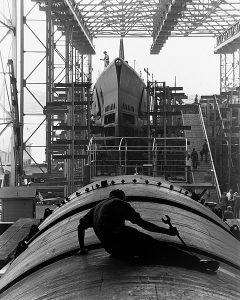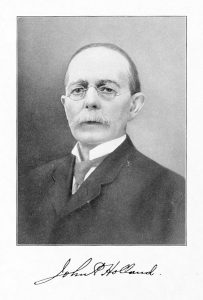By Sharon L. Cohen
Very rarely does an inventor immediately succeed when creating a new process or device. It typically takes a great deal of patience and the diligence of continuous improvement to bring desired results. Such was the case with the innovations of Irish-born-and-raised John P. Holland, father of the modern military submarine. Inspired by earlier Connecticut inventions, Holland’s company, Electric Boat, eventually became an industry leader in Groton.
Submarine Inventor Recognizes the Submarine’s Power
Holland was fascinated by the idea of submerged vessels like the Turtle—a prototype built by Connecticut inventor David Bushnell during the American Revolution. He was also intrigued by the Confederate army’s success in sinking the 1,200-ton US army ship Housatonic in a matter of minutes during the Civil War. Even though the Confederate’s 40-foot Hunley was just a quasi-submersible that did not fully function undersea, the vessel still had the advantage of striking adversaries from below the waterline. Holland became interested in the damage a submarine could do when fully submerged.
Leaving Ireland, Holland headed to the United States to seek greater reception to his ideas. Despite the navy turning down his designs several times, he continued development under his own company name. After some near-disastrous results, he finally enjoyed a successful launch in 1898—marking the first time a vessel supported by a combination of electric motors and gasoline engines (for both underwater and surface propulsion) submerged.
A Newly Formed Company Looks Toward the Future

Man working on hull of US submarine at Electric Boat Co. in Groton, CT, by Charles Fenno Jacobs, August 1943 – Wikimedia Commons
In 1899, Holland formed a partnership with investor Isaac L. Rice that they named the Electric Boat Company. They soon completed the Holland, a 54-foot military submarine, and the navy purchased it as the inaugural vessel of the US submarine force. In 1911, Electric Boat purchased the New London Ship and Engine Company in Groton, Connecticut, and set its sights on becoming an industry leader.
Electric Boat began building submarines during World War I. It was the decade between the Cuttlefish launch in 1934 and the end of World War II, however, that the company developed its most impressive list of accomplishments. Repeatedly, Electric Boat demonstrated how its submarines could successfully conduct a variety of operations such as anti-surface and antisubmarine warfare, intelligence gathering, land attacks, and defense of other fleet vessels.
WWII Displays Electric Boat’s Military Excellence
During WWII, a number of military events exemplified the impact of submarines—especially Electric Boat’s vessels—on 20th-century warfare. One incident took place at night when the submarine Barb surfaced near Japan’s Namkwan Harbor, slipped through a host of enemy escorts, and torpedoed into a concentration of 30 ships. Additionally, in a historic battle in the Philippines, the submarine Darter sank a large Japanese cruiser and damaged a second. Similarly, Dace, the first submarine launched at Electric Boat’s newly established Victory Yard, sank the heavy cruiser Maya, and the Sealion took out the 30,000-ton Japanese battleship Kongo using wakeless electric torpedoes that did not leave a visible trail. This latter attack was the first time in history that a navy vessel of any type destroyed a Japanese battleship unassisted.
Based on a December 1945 report, US submarines accounted for 63 percent of all Japanese ships sunk during WWII—Electric Boat’s vessels were responsible for a significant number of these successful outcomes, affirming John Holland’s belief in the ability of the submarine to change a war at sea. Today, Electric Boat is a subsidiary of General Dynamics Corporation, one of the largest defense contractors in the world.
Sharon L. Cohen is a communication specialist and professional writer who has authored several books on business and Connecticut communities.










